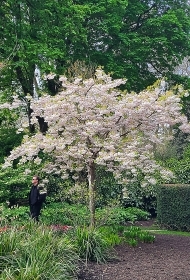Adam Yamey's Blog: YAMEY, page 17
April 24, 2025
Britain and social change thirty to forty years ago in photographs
THE FIRST ROOOM of the Tate’s exhibition of photographic images of Britain in the 1980s, “The 80s Photographing Britain”, was disappointing. There were too many small photographs, which would have been far easier to appreciate by seeing them in a catalogue or book. However, the other rooms of this show, which is on until 5 May 2025, contain many photographs that are often interesting as well as artistic. As the Tate’s website explained, during the ‘80s:
“… photography was used as a tool for social change, political activism, and artistic and photographic experiments.”
It continued to say that the visitor to the exhibition will:
“See powerful images that gave voice and visibility to underrepresented groups in society. This includes work depicting the Black arts movement, queer experience, South Asian diaspora and the representation of women in photography.”
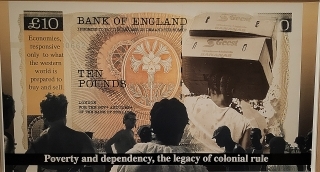
After my initial disappointment in the first room of the exhibition, I soon began enjoying the exciting range of pictures on display in the rest of the show. During most of the 1980s, I was working as a dentist in a small, rather conservative provincial district in Kent, and was largely unaware of the social changes that were going on around me. So, now, many years later after having seen the exhibition at the Tate Britain, it has only dawned on me what had passed me by while I was concentrating on looking after the dental health of some of the inhabitants of the Medway Towns.
Would I recommend seeing this show? My answer is ‘yes’, but hurry because it is ending soon.
April 23, 2025
Wood as art and the art of woodwork
DURING THE EASTER weekend, we visited two exhibitions. Unlike many exhibitions I have written about lately, neither of them finish soon. Both shows relate to wood and trees. One is being held at the Serpentine South Gallery in Kensington Gardens and it ends on 7 September 2025, and the other is at Japan House in High Street Kensington and continues until 6 July 2025. So, there is plenty of time to see both exhibitions.
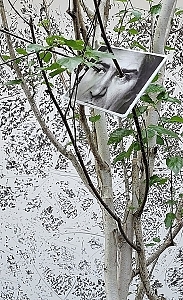 By Giuseppe Penone
By Giuseppe PenoneThe show at the Serpentine is of artworks by the Italian artist Giuseppe Penone. I have already written a bit about him (https://adam-yamey-writes.com/2025/04/15/boulders-lodged-in-trees-at-a-park-in-london/). I did this after seeing those of his works that are on display near the outside of the Serpentine Gallery. I have now seen what is on display within the gallery, and was pleasantly surprised. Penone is fascinated by the intricate relationships between humans and nature, and this is what inspires his artworks. Many of the artefacts (paintings, installations, and sculptures) on display relate to trees and their leaves. The walls of the central hall of the Serpentine Gallery are lined with containers that hold thousands of dead laurel leaves. Another exhibit consists of semi-abstract sculptures that resemble human forms, and these are entwined with living plants growing out of large flower pots. Other works are formed from pieces of wood and twigs. One particularly effective work consisted of living branches with leaves and twigs. One of the twigs has been forced through a hole cut in a photograph of a man’s face in such a way that the twig seems to have grown from within the centre of the eye. I like this piece because it encapsulates what Penone does: he sees nature through his eyes and is inspired by what he sees.
In contrast to Penone’s work at the Serpentine, which is art for art’s sake, the exhibition at Japan House is designed to illustrate how man can create artistic yet functional artefacts from wood. Called “The Craft of Carpentry: Drawing Life from Japan’s Forests”, the show sets out (successfully) to illustrate the amazing skills of traditional Japanese carpentry. This informatively labelled exhibition has exhibits showing the variety of tools used, the types of wood employed, the range of joinery methods, templates for cutting shapes, and some of the final products including a life-size replica of the Se-an teahouse in a temple in Kyoto. Although everything on display is related to creating functional products, each exhibit is so beautiful that it could be considered a work of art in its own right. As with every exhibition I have seen at Japan House, the exhibits are displayed imaginatively and beautifully. The exhibitions themselves are works of art.
I recommend visiting both exhibitions not only because they are fascinating but also because they illustrate two completely different approaches to dealing with trees and their wood.
April 22, 2025
A bird with two heads in London’s Earls Court
COLEHERNE COURT IS a large block of flats located on the corner of Old Brompton Road and Redcliffe Gardens. The late Princess Diana lived there before she married Prince Charles. At the corner of the building there is an entrance surmounted by a carving of a bird with two heads each on a long neck.
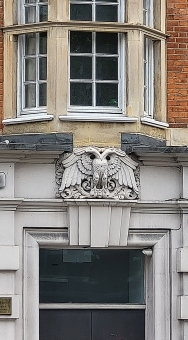
A map surveyed in 1916 indicates that there was a bank at this corner, The two headed bird was probably above its entrance. The only British bank I know of that uses the double-headed eagle as its symbol is Hoare’s Bank. There may have been others, but I do not know about them.
If anybody knows any more about the double-headed bird on the corner of Coleherne Court, do please let me know.
April 21, 2025
Does it matter which cricket team you support?
IN 1960, THE CONSERVATIVE politician Norman Tebbit devised what has become known as ‘the cricket test’ to ascertain how well immigrants had become integrated into the life of the United Kingdom and how loyal they had become to their adopted home. It related to which team they supported when the team from their country of origin was playing test cricket against a British team. He suggested that those immigrants who support their native country’s cricket team rather than England’s are not significantly integrated into the United Kingdom
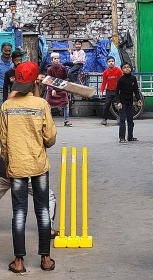
My father was an immigrant. He was born, brought up, and educated in South Africa. He took a keen interest in professional sport, when it was presented on the radio (we did not have a television at home). I remember seeing him sitting at his desk in his study working with the radio on in the background. He delighted in listening to radio commentaries of cricket and tennis matches. I am not sure whether he was able to visualise the games in his mind, or whether he was only interested in the scores, or both. When, after apartheid was ended in South Africa, and the South African cricketers were once again playing the English team, he was asked which of them he hoped would win. He said:
“It does not matter to me,” he replied, “I support both of them.”
I wonder whether this counted as a pass or fail in Tebbit’s cricket test?
April 20, 2025
Casting a shadow in London’s Kensington
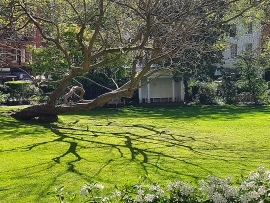
Even when the sun is not shining, this leaning tree in London’s Kensington Square is interesting enough from the visual point of view. It is amazing how much more entrancing and intriguing the scene becomes when the sun causes the tree to cast a shadow.
April 19, 2025
A sculpture in Central London that needs some care and attention
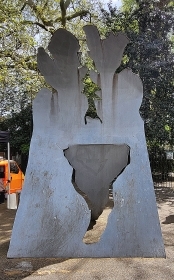
AT THE NORTHEAST corner of London’s Lincoln’s Inn Fields, there is a tall (15 feet high), wavelike, metal art work. I am undecided whether this sculpture by Barry Flanagan (1941-2009), who began studying at St Martins School of Art shortly before my mother stooped sculpting there, is a flattering addition to the historic Lincoln’s Inn Fields. Called “Camdonian” and constructed with a kind of steel, it was created in 1980.
It was restored in 2022, but now (April 2025), it is covered with graffiti and dirt including bird droppings. It needs to be cleaned up. As a sculpture, it appeals to me, but I do not feel that it enhances the locality where it is placed. Although it is large, it looks a bit lost where it is.
April 18, 2025
At the end of the week
April 17, 2025
The church that became a boat in northwest London
EVER SINCE THE early 1960s, I have travelled along Cambridge Avenue, which runs between Edgware Road and Kilburn Park Underground Station. I have always been in a car or bus. So, whenever I have passed what I am about to describe, I have never stopped to look at it carefully. Yesterday (14 April 2025), we stopped outside it to change buses.
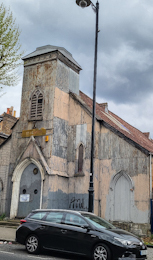
What I am referring to is an edifice made from sheets of corrugated iron, which looks like a Victorian gothic church. It looks slightly shapbby. Notices attached to it inform passers-by that it is a meeting place of the Sea Cadet Corps and it is now the ‘TS Bicester’, ‘TS’ standing for ‘Training Ship’. Known as the Tin Tabernacle, its history has been related on several websites including http://tintabernaclekilburn.org/history/ and https://englishbuildings.blogspot.com/2013/04/cambridge-avenue-london.html .
The church was erected as a temporary structure in 1863, when Kilburn was on the edge of the countryside. According to the Tabernacle’s own website, a local developer called James Bailey:
“… granted a lease to Rev. Woodhouse and the Trustees of Cambridge Road Chapel to build an iron church for Church of England worship at a cost of £1000. The agreement was to build a stone church or a row of 3 terraced houses by Michaelmas 1868. The church paid a yearly rent of £32.”
That deadline has long passed, and the tin church is still standing. The galvanised corrugated iron covers a timber and iron frame, and iron columns support the roof.
1863, the Tin Tabernacle was constructed and was initially called St James Church. It was probably intended to be a stop-gap church to be used while the nearby St Augustine’s Church was being built (it was completed in 1870). In 1948, the tin church, which was then known as ‘Cambridge Hall’, was assigned to the Willesden Sea Cadets for use as a social centre and training centre. In 1956, the HMS Bicester was scrapped. Between 1956 and the 1960s, the church was fitted out to reproduce the scrapped HMS Bicester, and the place was renamed TS Bicester. Sometime between 1960 and 1980, the church lost its spire. In 1998, the building was listed as Grade II, which gives it some protection against being demolished.
The Sea Cadets ceased using the church in 2011. Its naval interior has been preserved, and now the church is used occasionally for community and other events. Although I have seen its exterior, I would love to see inside this unusual edifice.
April 16, 2025
Do not throw it away because it might become valuable one day
AFTER MY DAD’S father died, his mother remarried Isaac, a merchant, who lived and worked in Port Elizabeth (South Africa).
In his holidays, both school and then later university, Dad, whose father had owned a general store (in Tulbagh, South Africa), helped his stepfather in his shop in Port Elizabeth. Once again, he was in an environment where he was acquiring first-hand experience of the workings of commerce, one of the foundations on which the study of economics is based. By all accounts, including the fact that Isaac could afford regular holidays in Europe, the business prospered. Dad told me that during his vacations, he used to help Isaac compile annual inventories of his stock.
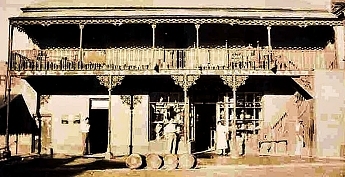 The shop owned by my father’s father in Tulbagh
The shop owned by my father’s father in TulbaghOne day, Dad came across many large glass bottles filled with boiled sweets that had become unsaleable because the candies had fused together to form huge masses. My father asked Isaac whether these bottles should be thrown out. He was told that they were to be retained. A few years later, WW2 broke out and there was a shortage of glass. Isaac sold the bottles filled with inedible sweets because the glass, now valuable, could be sold (for recycling) during the glass ‘famine’.
Was it experiences in his father’s and stepfather’s shops that might have led him to eventually become a professor of economics, and helped him to understand the concept of futures markets? I wonder.
April 15, 2025
Boulders lodged in trees at a park in London
WHEN WALKING IN Kensington Gardens March 2025, I spotted three trees planted in an open space outside the Serpentine South art gallery on the west side of Kensington Gardens. Taller than many of the trees around them, they had not been there when I visited the area in November 2024. Without foliage and with few branches, they seemed dead when compared with the trees growing near them. We revisited these unusual trees today (13 April 2025), and they looked wonderful in the morning sunshine.
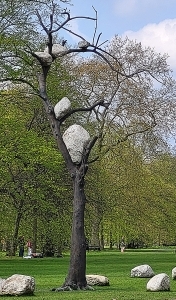
It does not take long to see that these trees have unusual features. Two of them have unwieldy granite boulders lodged in their branches. The third tree looks as if it has been split open by, for example. a lightning strike. Parts of the wood of this tree have been painted gold. Though in some respects these three tall objects look like trees, one realises quickly that they are not trees but artworks.
Created by the Italian artist Giuseppe Penone (born 1947), they are part of an exhibition of his works, most of which are housed within the Serpentine South Gallery. Penone was a leading artist in an Italian artistic movement known as ‘Arte Povera’, which focussed on exploiting the simplicity of natural materials with artistic techniques. According to the Serpentine’s website, Penone said of his exhibition:
“All of my work is a trial to express my adherence and belonging to nature, and it is with this thought that I have chosen the works for the exhibition. The two paths that I have created—inside the gallery and outside of it, in the park—become two integrated gardens.”
The three tree-like sculptures both impressed and intrigued me. I have yet to see the works inside the gallery, but there is still plenty of time to view them as the exhibition continues until 7 September 2025.

